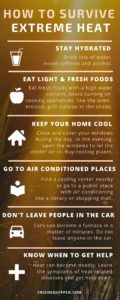
extreme heat is responsible for the highest number of annual deaths among all weather-related hazards
If you are under an extreme heat warning:
-
- Find air conditioning
- Avoid strenuous activities
- Wear light clothing
- Check on family members and neighbors
- Drink plenty of fluids
- Watch for heat cramps, heat exhaustion, and heat stroke.
- Never leave people or pets in a closed vehicle
prepare now
- Plan to have plenty of fluids on hand to keep your family well hydrated
- Replace filters in air conditioning units and have serviced if needed
- Install ceiling fans to help circulate air conditioned “cooled air” to save on electric consumption
- Ensure you can pull shades to keep rooms cooler during extreme daytime heat
- Prepare for power outages:
- stock up on bottled water supply
- check battery supply
- place gallon bags of water in freezer to help keep food frozen longer during power outages
- Know your county’s plans for cooled spaces during extreme heat waves in case you lose air conditioning capability
- Schedule outdoor events for early morning or evening and avoid sun exposure in midday
- Check on neighbors and ensure they too have plans for “staying cool”
be safe during
- Never leave a child, adult or animal alone inside a vehicle on a warm day
- Find places with air conditioning
- If you’re outside, find shade
- Wear loose, lightweight, light-colored clothing
- Drink plenty of fluids to stay hydrated
- Do not use electric fans when the temperature outside is more than 95 degrees
- Avoid high-energy activities
- Check yourself, family members, and neighbors for signs of heat-related illnesses.
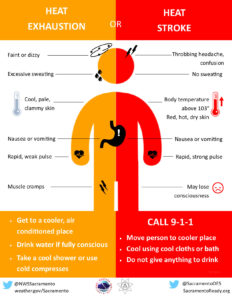
recognize + respond
Heat Cramps
- Signs: muscle pains or spasms in the stomach, arms or legs
- Actions: go to a cooler location. Remove excess clothing. Take sips of cool sports drinks with salt and sugar. If you are sick and need medical attention, call your healthcare provider first. Follow your healthcare provider’s instructions about whether you should go to the hospital or cooler location yourself, as you may be putting others or yourself in greater risk for contracting COVID-19. If cramps last more than hour, seek medical attention.
Heat Exhaustion
- Signs: heavy sweating, paleness, muscle cramps, tiredness, weakness, dizziness, headache, fainting, nausea, vomiting
- Actions: go to an air-conditioned place and lie down. Loosen or remove clothing. Take a cool bath. Take sips of a cool sports drink with salt and sugar. Call your healthcare provider if symptoms get worse or last more than an hour
Heat Stroke
- Signs: extremely high body temperature (above 103 degrees), red/hot/dry skin with no sweat, rapid/strong pulse, dizziness, confusion or unconsciousness
- Actions: Call 9-1-1 or get the person to a hospital immediately. Cool down with whatever methods are available until medical help arrives.
LOOK BEFORE YOU LOCK
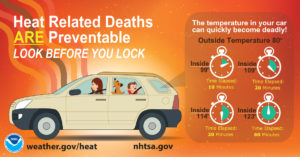
NEVER LEAVE YOUR CHILDREN LOCKED IN A PARKED CAR. EVEN WHEN IT FEELS COOL OUTSIDE, CARS CAN HEAT UP TO DANGEROUS TEMPERATURES VERY QUICKLY.
- A window open is not enough – temperatures inside the car can rise almost 20 degrees Fahrenheit within the first 10 minutes, even with a window cracked open
- Children who are left unattended in parked cars are at greatest risk for heat stroke, and possibly death.
- To remind yourself that a child is in the car, keep a stuffed animal in the car seat. When the child is buckled in, place the animal in the front with the driver.
- When leaving your car, check to be sure everyone is out of the car.
PET heat SAFETY
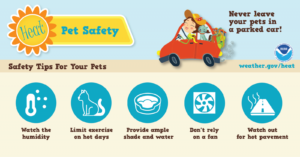
NEVER LEAVE YOUR PETS LOCKED IN A PARKED CAR. ANIMALS CAN DIE OF HEATSTROKE WITHIN 15 MINUTES.
- Even in cool temperatures, cars can heat up to dangerous temperatures very quickly
- A window open is not enough – temperatures inside the car can rise almost 20 degrees Fahrenheit within the first 10 minutes, even with a window cracked open
- If you see a pet in an unattended vehicle, do not leave until the problem has been resolved!
mosquito bite prevention
Not all mosquitoes are the same. Different mosquitoes spread different viruses and bite at different times of the day.
protect yourself and y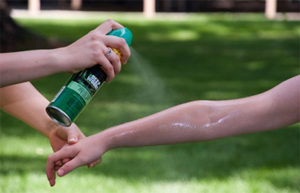 our family
our family
- Use insect repellent with one of the following active ingredients:
- DEET
- PICARDIN
- IR3535
- OIL OF LEMON EUCALYPTUS
- 2-UNDECANONE
- Always follow the product label instructions
- Reapply insect repellent every few hours, depending on which product and strength you use
protect your baby or child
- Follow instructions when applying insect repellent to children
- Do not use insect repellent on babies younger than 2 months of age
- Dress your child in clothing that covers arms and legs or…
- Cover crib, stroller, and baby carrier with mosquito netting
- Do not apply insect repellent onto a child’s hands, eyes, mouth and cut or irritated skin
- Do not oils products containing oil of lemon eucalyptus on children under 3 years of age
treat clothing and gear
- Treat items such as boots, pants, socks and tents with permethrin or purchase permethrin-treated clothing and gear
- Do not use permethrin products directly on the skin
mosquito proof your home
- Use screens on windows and doors. Repair holes in screens to keep mosquitoes outside
- Use air conditioning when available
- Keep mosquitoes from laying eggs in and near standing water (tires, buckets, planters, pools, birdbaths, flowerpots, or trash containers). Check inside and outside your home.
ticks and lyme disease safety
children & lyme disease
- Although anyone can get Lyme Disease, children spend a lot of time outdoors and are at particular risk.
- Reasons to suspect your child may have Lyme Disease: your family lives in or has visited a region where Lyme disease is commonly found, you know or suspect that your child has been exposed to ticks, your child is experiencing symptoms such as rash, fever, chills, fatigue, joint or muscle pain, or facial paralysis.
what to expect from your child’s appointment
- If the doctor thinks that your child has Lyme Disease based on symptoms and possible exposure, your child will most likely receive 2-4 weeks of antibiotics.
- If you child’s symptoms are not clear-cut, the doctor may decide to have the child’s blood tested. Keep in mind the blood testing is more accurate the longer the child has been infected. A blood test for Lyme Disease may not appear positive until 3-4 weeks after infection. Therefore, a doctor may order a later, second test if the first test was negative.
treatment of lyme disease in children
- A typical treatment for children less than 8-years-old would include oral amoxicillin three times daily for 2-4 weeks. Children who are allergic to amoxicillin would most likely receive cefuroxime axetil twice daily instead.
- A typical treatment for children over 8-years-old would include doxycycline twice a daily for 2-4 weeks. Children who are allergic to tetracyclines would receive amoxicillin or cefuroxime axetil instead.
helping your child recover
- Give your child the complete course of antibiotics as recommended. Make sure that they get plenty of rest so that they can recover. Joint pain may take longer to go away than other symptoms.
- Some people wonder if there is a test to confirm that their child is cured. This is not currently possible because the immune system remembers an infection long after it has been cured. Blood tests can remain positive for months or years. Don’t be alarmed. This doesn’t mean your child is still infected.
- Most importantly, practice prevention against tick bites. Kids can get Lyme Disease again if they are bitten by another infected tick.
protect your family from lyme disease
- Use insect repellant that contains 20-30% DEET. Follow the instructions on the packaging.
- Make children bathe or shower as soon as possible after they come indoors.
- Look for ticks on their bodies. Ticks can hide under the arm pits, behind the knees, in the hair, in the groin.
- Put clothes in the dryer on high heat for 60 minutes to kill any remaining ticks.
don’t let a tick make you sick
what is a tick?
- Ticks are related to spiders. They have 8 legs. But they don’t spin webs and they don’t eat insects. All ticks are small but backlegged ticks (sometimes called deer ticks) are very small.
where do ticks live?
- Ticks live in places where there is a lot of tall grass, shrubs, and leaves.
- Ticks wait for an animal (like a deer, mouse or a dog) or a person to walk by. Then they grab on to the animal or human.
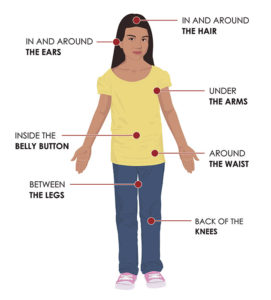
how do ticks bite us?
- After climbing on a person or animal, ticks find a good place to attach themselves. They might hide in your hair, behind the knee, even in your underwear!
- Then, the ticks bite into a person or animal’s skin and start drinking their blood. Tick bites don’t usually hurt, so you may not even notice it.
- The tick can stay attached for a few days. When it is full, it will fall off.
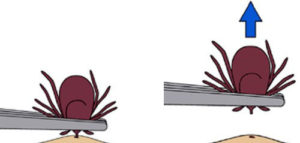 what if i find a tick on me?
what if i find a tick on me?
- If you find a tick on your body, tell your parents or teacher. They can use tweezers to pull it off. Then they should wash the bite with soap and water or disinfectant.
how can i keep ticks away?
- You can wear insect repellant and stay out of tall weeds. If you are in a place where ticks live, take a bath or shower after you come inside. Let your parents check you for ticks afterwards.
- Also, tell your parents that there are things they can do to keep ticks out of the yard.
how can I stay healthy?
- If a tick bites you and soon after you get a fever, skin rash, or feel really, really, tired, tell your parents. The tick may have given you some germs. See your doctor to find out if you need medicine.
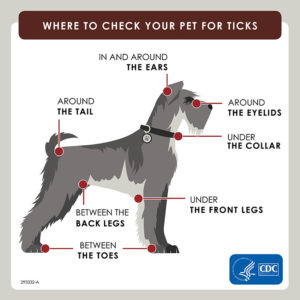
preventing ticks on your pets
- Dogs are very susceptible to tick bites and tickborne diseases. Vaccines are not available for most of the tickborne diseases that dogs can get, and they don’t keep the dogs from bringing ticks into your home. For these reasons, it’s important to use a tick preventive product on your dog.
- Tick bites on dogs may be hard to detect. Signs of tickborne disease may not appear for 7-21 days or longer after a tick bite, so watch your dog closely for changes in behavior or appetite if you suspect that your pet has been bitten by a tick.
- Talk to your veterinarian about:
- The best tick prevention products for your dog
- Tickborne diseases in your area
- To further reduce the chances that a tick bite will make your dog sick:
- Check your pets for ticks daily, especially after they spend time outdoors.
- If you find a tick on your pet, remove it right away.
- Reduce tick habitat in your yard.
- Note: Cats are extremely sensitive to a variety of chemicals. Do not apply any tick prevention products to your cats without first asking your veterinarian!
droughts

Defined as a lack of precipitation over an extended period of time, resulting in water shortages. They can happen anywhere in the United States.
prepare now
The best way to prepare for a drought is to conserve water. Make conserving water a part of your daily life.
Indoor Water Conservation Tips Before a Drought
GENERAL
- Never pour water down the drain when there may be another use for it. For example, use it to water your indoor plants or garden.
- Fix dripping faucets by replacing washers. One drop per second wastes 2,700 gallons of water a year.
- Check all plumbing for leaks and have any leaks repaired by a plumber.
- Retrofit all household faucets by installing aerators with flow restrictors.
- Install an instant hot water heater on your sink.
- Insulate your water pipes to reduce heat loss and prevent them from breaking.
- Install a water-softening system only when the minerals in the water would damage your pipes. Turn the softener off while on vacation.
- Choose appliances that are more energy and water efficient.
BATHROOM
- Consider purchasing a low-volume toilet that uses less than half the water of older models. Note: In many areas, low-volume units are required by law.
- Install a toilet displacement device to cut down on the amount of water needed to flush. Place a one-gallon plastic jug of water into the tank to displace toilet flow. Make sure it does not interfere with the operating parts.
- Replace your showerhead with an ultra-low-flow version.
KITCHEN
- Instead of using the garbage disposal, throw food in the garbage or start a compost pile to dispose it.
Outdoor Water Conservation Tips Before a Drought
GENERAL
- Check your well pump periodically. If the automatic pump turns on and off while water is not being used, you have a leak.
- Plant native and/or drought-tolerant grasses, ground covers, shrubs and trees. Once established, your plants won’t need as much watering. Group plants together based on similar water needs.
- Don’t buy water toys that require a constant stream of water.
- Don’t install ornamental water features (such as fountains) unless they use re-circulated water.
- Consider rainwater harvesting where practical.
- Contact your local water provider for information and assistance.
LAWN CARE
- Position sprinklers so water lands on the lawn and shrubs and not on paved areas.
- Repair sprinklers that spray a fine mist.
- Check sprinkler systems and timing devices regularly to be sure they operate properly.
- Raise the lawn mower blade to at least three inches or to its highest level. A higher cut encourages grass roots to grow deeper and holds soil moisture.
- Plant drought-resistant lawn seed. Reduce or eliminate lawn areas that are not used frequently.
- Don’t over-fertilize your lawn. Applying fertilizer increases the need for water. Apply fertilizers that contain slow-release, water-insoluble forms of nitrogen.
- Choose a water-efficient irrigation system such as drip irrigation for your trees, shrubs and flowers.
- Turn irrigation down in fall and off in winter. Water manually in winter only if needed.
- Use mulch around trees and plants to retain moisture in the soil. Mulch also helps control weeds that compete with plants for water.
- Invest in a weather-based irrigation controller—or a smart controller. These devices will automatically adjust the watering time and frequency based on soil moisture, rain, wind, and evaporation and transpiration rates. Check with your local water agency to see if there is a rebate available for the purchase of a smart controller.
POOL
-
- Install a new water-saving pool filter. A single back flushing with a traditional filter uses 180 to 250 gallons of water.
- Cover pools and spas to reduce water evaporation.
stay safe during
Always observe state and local restrictions on water use during a drought. Contact your state or local government for current information and suggestions.
Indoor Water Conservation Tips During a Drought
BATHROOM
- Avoid flushing the toilet unnecessarily. Dispose of tissues, insects and other similar waste in the trash rather than the toilet.
- Take short showers instead of baths. Turn on the water only to get wet and lather and then again to rinse off.
- Avoid letting the water run while brushing your teeth, washing your face or shaving.
- Place a bucket in the shower to catch excess water for watering plants.
KITCHEN
- Operate automatic dishwashers only when they are fully loaded. Use the “light wash” feature to use less water.
- Hand wash dishes by filling two containers—one with soapy water and the other with rinse water containing a small amount of chlorine bleach.
- Clean vegetables in a pan filled with water rather than running water from the tap.
- Store drinking water in the refrigerator. Do not let the tap run while you are waiting for water to cool.
- Avoid wasting water waiting for it to get hot. Capture it for other uses such as plant watering or heat it on the stove or in a microwave.
- Don’t rinse dishes before placing them in the dishwasher, just remove large particles of food.
- Avoid using running water to thaw meat or other frozen foods. Defrost food overnight in the refrigerator or use the defrost setting on your microwave.
LAUNDRY
- Operate clothes washers only when they are fully loaded or set the water level for the size of your load.
Outdoor Water Conservation Tips During a Drought
CAR WASHING
- Use a commercial car wash that recycles water.
- If you wash your own car, use a shut-off nozzle that can be adjusted down to a fine spray on your hose.
LAWN CARE
-
- Avoid over watering your lawn and water only when needed.
- A heavy rain eliminates the need for watering for up to two weeks. Most of the year, lawns only need one inch of water per week.
- Check the soil moisture levels with a soil probe, spade or large screwdriver. You don’t need to water if the soil is still moist. If your grass springs back when you step on it, it doesn’t need water yet.
- If your lawn does require watering, do so early in the morning or later in the evening, when temperatures are cooler.
- Check your sprinkler system frequently and adjust sprinklers so only your lawn is watered and not the house, sidewalk, or street.
- Water in several short sessions rather than one long one, in order for your lawn to better absorb moisture and avoid runoff.
- Use a broom or blower instead of a hose to clean leaves and other debris from your driveway or sidewalk.
- Avoid leaving sprinklers or hoses unattended. A garden hose can pour out 600 gallons or more in only a few hours.
- In extreme drought, allow lawns to die in favor of preserving trees and large shrubs.
FOR MORE INFORMATION:
- noheatstroke.org
- cdc.gov
- ready.gov
- United States Drought Monitor
- Drought: Everything You Need to Know
- Drought Preparedness | Water Conservation | Red Cross
